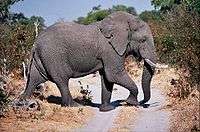Moremi Game Reserve
Moremi Game Reserve is a Game Reserve in Botswana. It rests on the eastern side of the Okavango Delta and was named after Chief Moremi of the BaTawana tribe. Moremi was designated as a Game Reserve, and not a National Park, when it was created. This designation meant local people, the BaSarwa or Bushmen that lived there were allowed to stay in the reserve.

The Moremi Game Reserve covers much of the eastern side of the Okavango Delta and combines permanent water with drier areas, which create some startling and unexpected contrasts. Some prominent geographical features of the Reserve are Chiefs Island and the Moremi Tongue.[1] In the Moremi Reserve one can experience excellent views of Savannah game as well as bird-watching on the lagoons. There are also thickly wooded areas, which are home to the Cape wild dog and leopard. To the northeast lies the Chobe National Park which borders the Moremi Game Reserve.
Although just under 5,000 square kilometres (1,900 sq mi) in extent, it is a surprisingly diverse Reserve, combining mopane woodland and acacia forests, floodplains and lagoons. Only about 30% of the Reserve is mainland, with the bulk being within the Okavango Delta itself.
The Moremi Game Reserve, although not one of the largest parks, presents insights and views even for the most experienced of travelers. It is home to nearly 500 species of bird (from water birds to forest dwellers), and a vast array of other species of wildlife including Cape buffalo, Angolan giraffe, black rhinoceros, Southwest African lion, elephant, hippopotamus, zebra, South African cheetah, hyena, jackal, impala, and red lechwe. Cape wild dogs (Lycaon pictus pictus) inhabit this reserve[2] and has been the subject of a project run in the area since 1989; thus this species is often seen wearing collars emplaced by researchers. The Moremi area contains one of the most significant extant habitat areas for L. pictus.
Logistics
The Reserve offers the opportunity to explore not only in 4x4's but on foot and by mokoro—a dug-out canoe, hewn from either ebony or sausage-tree, and poled by your personal guide. Although, today most of the mekoro (plural of mokoro), are made from fibreglass, thus helping to preserve the magnificent, and old, trees of the area.
Game viewing is at its peak from July to October, when seasonal pans dry up and the wildlife concentrates on the permanent water. From October until the start of the rains in late November or early December, the weather can be extremely hot.
Malarial mosquitoes are prevalent throughout the Reserve and it is strongly recommended that visitors should take precautions before, during and after a visit.
Botswana has been able to develop its tourism without the urgent need for revenues that face many other African countries. An eco-tourism policy of high yield, but low impact, has resulted in visitors being able to experience an Africa in its most natural, unspoilt and impressive condition. Thus the Reserve itself has very few lodges, and only four areas set-aside for camping (at South Gate, Third Bridge, Xakanaxa, and Khwai). There are a number of lodges on the outskirts of the Reserve, whose guests visit on daily game drives.
Travel between lodges is accomplished by light aircraft and helicopter transfers, as most lodges have their own airstrips. Therefore, you can easily combine a number of lodges in a variety of areas. Helicopter game viewing flights are available from most lodges.[3]
References
- C. Michael Hogan. 2009. Painted Hunting Dog: Lycaon pictus, GlobalTwitcher.com, ed. N. Stromberg
- Alan Murphy, Kate Armstrong, Matthew D Firestone, Mary Fitzpatrick. 2007. Southern Africa, Edition: 4, Lonely Planet Publications, 512 pages ISBN 1-74059-745-1, ISBN 978-1-74059-745-6
Line notes
Notes
This park is considered for inclusion in the 5 Nation Kavango–Zambezi Transfrontier Conservation Area.
External links
| Wikimedia Commons has media related to Moremi Wildlife Reserve. |
- Moremi Game Reserve website
- Map of Moremi Game Reserve
- Photo gallery from Moremi Game Reserve
- Website with information for booking campsites in Moremi GR
Coordinates: 19°10′S 23°10′E / 19.167°S 23.167°E